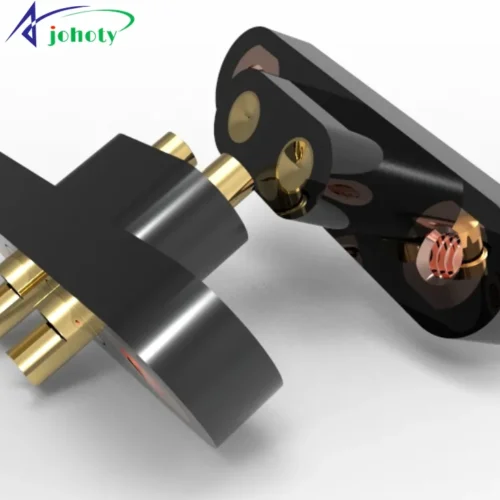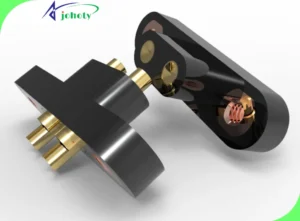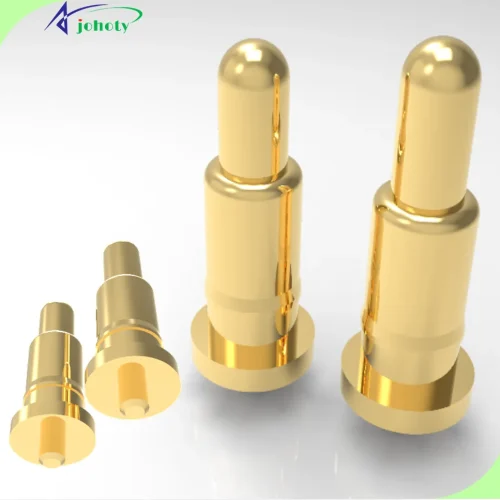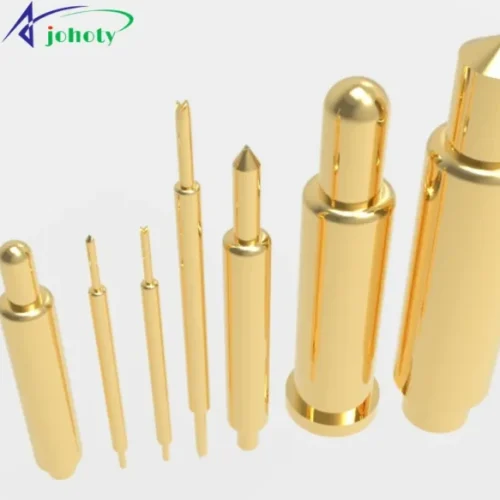2 pin connectors in industrial automation, Explore their applications of effectively saving sensor space and reducing costs. Strongly provide engineers with a professional guide to optimized design.
2 pin connectors significantly enhance efficiency and cost-effectiveness in industrial automation systems by saving space and reducing costs for sensors:
- Simplify wiring design: Simple designs of 2 pin connectors reduce the number of cables needed for sensor installation and connection, saving wiring space.
- Reduce wiring errors: With simpler wiring, 2 pin connectors lower the risk of wiring errors during installation, reducing debugging and maintenance costs.
- Improve system compactness: Occupying less space, 2 pin connectors enable more compact sensor system designs, accommodating smaller installation space requirements.
- Lower material costs: Using fewer cables and connector components directly reduces material and procurement expenses.
Simplify maintenance: With their straightforward design, connectors are easier and quicker to maintain and replace, further reducing long-term maintenance costs.
The Importance of 2-Pin Connectors in Industrial Automation
The role of 2 pin connectors is critical in industrial automation. Celebrated for their simple design, compact stature, and reliable operation. Making them an ideal choice for optimizing sensor system layouts and reducing overall costs.
Key Points for Space Savings
- Simplified wiring design: 2 pin connectors reduce the number of cables, ensuring a more orderly and space-efficient sensor system installation.
- Compact connector structure: Their small design allows sensors and other components to be arranged more tightly, effectively utilizing limited space.
Key Points for Cost Savings
- Reduced material costs: By using fewer cables and connectors, the 2 pin connector directly lowers material procurement expenses.
- Lower installation and maintenance costs: Simplified connection methods reduce installation complexity and time, cutting labor costs. They are also easier to maintain and replace, further reducing operational expenses.
Design Advantages of 2 Pin Connectors in Industrial Automation Sensors
Simple Structure
- the 2 pin connector features a straightforward design that reduces complexity, making installation and maintenance easier. This design not only lowers the risk of errors but also enhances industrial automation system stability and reliability.
Compact Size
- Due to their small dimensions, the 2 pin connector is particularly suitable for space-constrained environments. They can easily integrate into small devices or dense sensor networks, optimizing space utilization.
High Reliability
- 2 pin connectors typically use high-quality materials and precise manufacturing processes, ensuring robust and durable connections. This reliability reduces downtime caused by connection failures, enhancing overall system efficiency.
Cost-effectiveness
- By reducing the number of cables and components needed, the 2 pin connector significantly lower material costs. Additionally, simplified installation and maintenance processes further reduce labor expenses. Overall, the 2 pin connector achieves efficient connections while substantially reducing total system costs.
Easy Integration
- With strong versatility, the 2 pin connector seamlessly integrates with various types of sensors and devices. This compatibility allows engineers to flexibly design and configure automation systems to meet diverse application needs.
Improved System Compactness
- By minimizing the space occupied by connectors and cables, the 2 pin connector enables more compact system designs. This not only economizes on space but also boosts system aesthetics and functionality.
Reduced Electrical Noise
- The design of the 2 pin connector effectively reduces electrical noise and interference, ensuring stable and accurate signal transmission. This is crucial for high-precision sensors and sensitive equipment, enhancing the overall performance of the automation system.
How 2 Pin Connectors Save Sensor Space in Industrial Automation?
Maximizing space efficiency is essential in the design of industrial automation systems. the 2 pin connector significantly saves sensor installation space and enhances system compactness and efficiency through their unique design and application.
Simplified Wiring Design
- 2 pin connectors streamline wiring by reducing the number of cables required for sensor systems. Compared to traditional multi-pin connectors, the 2 pin connector only needs two cables for connection, greatly reducing wiring complexity and space usage.
- This simplified wiring not only speeds up installation but also keeps the entire system neat.
Reduced Connection Points
- The design of the 2 pin connector reduces the number of connection points, thereby shrinking the overall size of sensor modules.
- In scenarios requiring dense sensor deployment, fewer connection points mean more sensors can be installed in the same space. This can greatly improve space utilization.
Compact Connector Size
- The 2 pin connector has a small footprint, occupying minimal space. This compact design allows them to integrate easily into small devices or sensor arrays, facilitating a more compact system layout.
- This advantage is particularly significant in space-constrained industrial automation environments.
Modular Design
- Many 2 pin connectors feature a modular design, allowing multiple sensors to share a single connector module. This design further reduces the number of individual connectors, optimizing space utilization.
- Moreover, modular design facilitates maintenance and upgrades, enhancing system flexibility.
Reduced Cable Lengths
- The simplified wiring of the 2 pin connector also reduces the required cable lengths. Shorter cables not only save space but also reduce cable management complexity, improving system cleanliness and aesthetics.
Integrated Applications
- The 2 pin connector is versatile and seamlessly integrates with various types of sensors and automation equipment.
- Their compact size and simple design effectively save space in integrated applications, enhancing overall system performance.
How 2 Pin Connectors Reduce Sensor Costs in Industrial Automation?
Reduced Material Costs
- The simple design of the 2 pin connector requires only two cables for connection. This greatly diminishes the need for cables and connector parts.
- Compared to traditional multi-pin connectors, 2 pin connectors require fewer materials, directly lowering procurement costs.
- Additionally, reduced material usage contributes to lower environmental impact, aligning with green manufacturing trends.
Lower Installation Costs
- The installation process of the 2 pin connector is quick and straightforward, reducing installation time and labor costs.
- Due to their straightforward design, the likelihood of errors during installation is greatly reduced, minimizing rework and debugging expenses.
- In large-scale industrial automation projects, these savings in installation costs are particularly significant.
Simplified Maintenance and Replacement
- Maintaining and replacing 2 pin connectors is straightforward, reducing system downtime and maintenance costs.
- Traditional multi-pin connectors often require complex maintenance, whereas the 2 pin connector is easy to assemble and disassemble. Shortening repair times and improving equipment operational efficiency and reliability.
Increased Production Efficiency
- The simplified wiring of the 2 pin connector optimizes system design. It reduces the complexity of sensor placement and enhances overall production line efficiency.
- Higher production efficiency means more products can be manufactured per unit time, thereby reducing unit production costs.
Reduced Inventory and Logistics Costs
- 2 pin connectors require fewer components, simplifying inventory management and reducing costs.
- Reduced inventory not only lowers capital requirements but also reduces warehouse space and management expenses.
- Moreover, simplified components reduce the complexity and cost of logistics transportation, enhancing overall supply chain efficiency.
Reduced Electrical Noise and Interference
- The design of the 2 pin connector effectively reduces electrical noise and interference, ensuring stable and accurate signal transmission.
- This reduces equipment failure and maintenance costs due to signal issues, enhancing system reliability and stability.
Successful Application of 2 Pin Connectors in Industrial Automation Sensors for Space and Cost Savings
1. Optimization of Production Lines in a Large Automobile Manufacturing Plant
Background
A large automobile manufacturing plant faced challenges with complex sensor layouts, limited space, and high costs on their production lines. To improve production efficiency and reduce costs, engineers decided to optimize the existing system using the 2 pin connector.
Implementation Process:
Simplified Wiring
- By using the 2 pin connector, sensor wiring on the production line was simplified. It is from a complex multi-pin connector system to dual-wire connections. This significantly reduces the number of cables.
Layout Optimization
- The compact size of 2 pin connectors allowed sensors to be placed more closely together. Improving space utilization and freeing up more production line space.
Reduced Material and Installation Costs
- The use of 2 pin connectors reduced material costs by 25% and shortened installation time by 30%. This results in significant reductions in labor and material procurement expenses.
Achievements
- Space Savings: Sensor placement space was reduced by 40%, providing more space for the installation and operation of other equipment.
- Cost Reduction: Overall sensor system costs decreased by 20%, including savings in material, installation, and maintenance costs.
- Increased Production Efficiency: Simplified wiring and optimized layout enhanced the overall operational efficiency of the production line, reducing downtime.
2. Upgrade of Smart Warehouse System
Background
A smart warehouse company, the client faced challenges with complex sensor layouts and high maintenance costs when upgrading their warehouse. With the goal of enhancing system efficiency and cutting down on operational expenses, they selected our 2 pin connectors for system refurbishment.
Implementation Process
Reduced Connection Points
- After adopting 2 pin connectors, reducing the sensor system’s connection points by 50%. This resulted in more orderly and simplified wiring.
Modular Design
- The modular design of the 2 pin connector allowed multiple sensors to share a single connection module. Further reducing the number of standalone connectors and optimizing space utilization.
Simplified Maintenance
- Due to the ease of disassembly and replacement with the 2 pin connector, maintenance time was reduced by 40%. This significantly lowered maintenance costs.
Achievements
- Space Savings: The overall footprint of the sensor system decreased by 35%, providing more operational space for the warehouse system.
- Cost Reduction: Overall maintenance and operational costs decreased by 30%, including savings in material, installation, and maintenance costs.
- Improved System Reliability: With fewer connection points and simplified wiring, the system’s failure rate decreased by 20%, enhancing operational stability.
Future Trends of 2 Pin Connectors in Industrial Automation Sensors
Miniaturization and Integration
As industrial equipment trends towards miniaturization and higher integration, the compact design of the 2 pin connector becomes increasingly crucial. Moving forward, 2 pin connectors will progress towards smaller, lighter, and more efficient configurations. This can meet the demands of miniaturized equipment and sensor systems.
- Miniaturization Technology: Research and development of smaller-sized 2 pin connectors to fit into even tighter installation spaces.
- Integrated Design: Integration of the 2 pin connector with other electronic components to form modular solutions, further optimizing space utilization.
Smart and IoT Applications
With the proliferation of the Industrial Internet of Things (IIoT), the scale and complexity of sensor networks continue to grow. The importance of 2 pin connectors in smart and IoT applications will become more prominent.
- Smart Connectors: Development of smart 2 pin connectors with self-diagnostic and data transmission capabilities to enhance system intelligence.
- IoT Compatibility: Enhancing compatibility of the 2 pin connector in IoT, supporting multiple communication protocols and data formats to meet diverse application needs.
High-Performance Materials and Durability
To withstand the harsh conditions of industrial environments, future 2 pin connectors will utilize higher-performance materials. It can enhance durability and reliability.
- High-Temperature and Corrosion-Resistant Materials: Use of materials capable of withstanding extreme temperatures and corrosive environments to extend connector lifespan.
- High-Strength Design: Optimization of structural design to improve mechanical strength and vibration resistance of connectors. Ensuring stability in challenging environments.
Cost Optimization and Sustainability
In the future, the 2 pin connector will continue to play a crucial role in cost reduction and sustainability.
- Manufacturing Cost Reduction: Continued cost savings in manufacturing through enhanced production methods and innovative material choices.
- Eco-Friendly Materials: Adoption of recyclable and eco-friendly materials to reduce environmental footprint, in line with sustainable manufacturing trends.
Standardization and Compatibility
As industrial automation systems expand, standardization and compatibility will become increasingly important. the 2 pin connector will evolve towards higher standardization and broader compatibility.
- International Standards: Promotion of international standardization for the 2 pin connector to ensure global compatibility and interchangeability.
- Multi-functional Compatibility: Design of the 2 pin connector compatible with multiple sensors and devices to enhance application flexibility across different systems.
Conclusions:
In industrial automation, the 2 pin connector stands out as the ideal choice for engineers optimizing sensor systems. Because of their simple design, efficient performance, and significant cost-effectiveness. Reducing wiring complexity, optimizing space utilization, and lowering material and maintenance costs. 2-pin connectors demonstrate outstanding application value in industrial automation sensor systems.
Space Savings
- The compact design and simplified wiring solutions of the 2 pin connector drastically reduce the installation space required for sensor systems. It enables a more compact equipment layout. This frees up more space for other critical components, enhancing system efficiency and reliability.
Cost Reduction
2 pin connectors effectively lower the overall costs of sensor systems by reducing material usage, simplifying installation complexity, and streamlining maintenance processes. Their efficient performance and durability further reduce long-term operational and maintenance expenses, delivering substantial cost benefits. As professionals in industrial automation, adopting 2 pin connectors actively contributes to enhancing overall system performance and economic benefits. We recommend:
- Fully understanding the design advantages of 2 pin connectors and leveraging their space-saving and cost-reducing features in system designs.
- Keeping abreast of the latest technologies and application trends of 2 pin connectors. To stay ahead in the industry.
- Collaborating with us to explore best practices for the specific application of 2 pin connectors in projects. Further optimizing your industrial automation systems.














